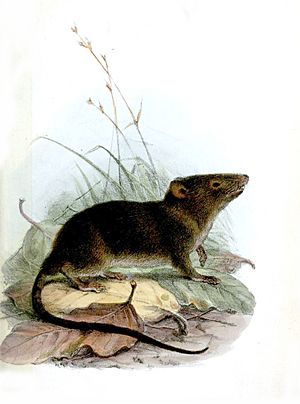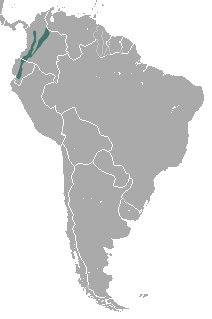Dusky caenolestid facts for kids
The dusky caenolestid (Caenolestes fuliginosus), also called Tate's shrew opossum, is a small mammal from South America. It looks a bit like a shrew and an opossum combined! This animal has dark brown fur that is soft and thick, with a lighter belly. Its tail is covered in loose hair.
The dusky caenolestid is a nocturnal animal, meaning it is most active at night. It lives in trees and eats insects and other small creatures. You can find it in the high mountain forests of northern and western Colombia, Ecuador, and western Venezuela. Experts say this shrew opossum is of "least concern" for its survival, which means there are still many of them around.
Quick facts for kids Dusky caenolestid |
|
|---|---|
 |
|
| Conservation status | |
| Scientific classification | |
| Genus: |
Caenolestes
|
| Species: |
fuliginosus
|
| Subspecies | |
Hyracodon fuliginosus (Tomes, 1863) |
|
 |
|
| Range of the dusky caenolestid | |
| Synonyms | |
|
Caenolestes obscurus Thomas, 1895 |
|
What's in a Name?
The dusky caenolestid is one of five types of animals in the Caenolestes group. They all belong to the family called Caenolestidae, which are known as shrew opossums.
An English zoologist named Robert Fisher Tomes first described this animal in 1863. He called it Hyracodon fuliginosus. Later, in 1895, another English zoologist, Oldfield Thomas, gave it its current scientific name, Caenolestes fuliginosus.
The name Caenolestes comes from two ancient Greek words: kainos, which means "new," and lestes, which means "robber" or "pirate." So, its name basically means "new robber"!
Scientists have studied how different shrew opossums are related. The Incan caenolestid and the long-nosed caenolestid are close relatives. They are like cousins to the Caenolestes group, which includes the dusky caenolestid.
There are three main types, or subspecies, of the dusky caenolestid:
- C. f. centralis (Bublitz, 1987): Found in the Andean natural region of Colombia and the very west of Venezuela.
- C. f. fuliginosus (Tomes, 1863): Lives in central Ecuador.
- C. f. obscurus (Thomas, 1895): Found near Bogotá, Colombia.
Fossils of animals similar to caenolestids have been found that are nearly 55 million years old!
Appearance
The dusky caenolestid has a dark brown coat with a lighter color on its belly. Its fur is very soft and thick. Its tail is covered in loose hair.
From its head to the base of its tail, it measures between 9.3 and 13.5 centimetres (3.7 and 5.3 in) long. Its tail is about 9.3 to 12.7 centimetres (3.7 to 5.0 in) long, and its hind feet are about 2.2 centimetres (0.87 in) long.
Compared to other caenolestids, the dusky caenolestid has smaller ears and eyes. Its snout (the front part of its head) is longer. Each of its front paws has five toes. Two of these toes are blunt, but the other three have sharp claws. Its back toes also have sharp claws, except for the biggest one.
This animal has four teats, but it does not have a pouch like many other marsupials. Sometimes, these animals can have unusual teeth, like missing teeth or extra teeth.
Life and Habits
The dusky caenolestid is a nocturnal animal, meaning it is active mostly at night. It spends its life living in trees. It can run very fast, similar to the Incan caenolestid. However, it doesn't move by leaping and jumping.
It is believed that the dusky caenolestid does not see very well. But its senses of smell and hearing are very good, which helps it find food and avoid danger in the dark.
Its diet mainly includes insect larvae (like caterpillars), other insects, small rodents, spiders, and centipedes. It might also eat some plant material. Even though its tail can grip things, it might not be strong enough to hold the animal's full weight if it hangs from a branch.
Where They Live and Their Status
The dusky caenolestid lives in the high mountain forests called alpine and páramo forests. You can find them in northern and western Colombia, Ecuador, and western Venezuela. They live at very high altitudes, from about 1,600–4,000 metres (5,200–13,100 ft) above sea level.
The IUCN (International Union for Conservation of Nature) lists the dusky caenolestid as "least concern" for its survival. This is because it lives in a wide area, and there are likely many of them.
However, in some mountain areas of Ecuador, the dusky caenolestid faces competition from another small animal called the wandering small-eared shrew. This competition can make the dusky caenolestid rarer in those specific places. Also, cattle grazing can damage their habitat, which is a problem for them.
See also
 In Spanish: Caenolestes fuliginosus para niños
In Spanish: Caenolestes fuliginosus para niños


